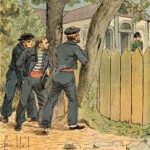Guarding Napoleon
Life was dull on St Helena. Duties were repetitive and mostly un-military compared to the excitements and dangers of war. The Regiment was quartered in a tented camp on Deadwood Plain. The weather was hot in summer and in winter a cold wind swept from the Antarctic. The Governor, Sir Hudson Lowe was obsessed with the security of his prisoner and both fixed and mobile picquets were organised day and night throughout the island.
The only diversion was the endless gossip about Napoleon and his household at Longwood House where he lived. The Regiment supplied a series of Orderly Officers who were responsible to the Governor for the sighting of the prisoner on at least two occasions each day. This often required playing hide and seek with Napoleon who enjoyed baiting the Orderly Officer and the guards (See ‘Making Trouble on St Helena’ in the Napoleon’s Final Years theme). The Governor organised signal flags to be placed in line of sight between Longwood House and key installations including Plantation House, his residence, Deadwood and the barracks in Jamestown. Different coloured flags would be flown to denote the level of current risk: Blue for ‘all’s well’ and red for ‘the prisoner is missing’.
The passengers on every visiting ship wanted a sight of Napoleon.
 These often took place whilst he was walking in Longwood’s extensive gardens. For important visitors, negotiations were required with Napoleon’s Chief of Staff, Count Bertrand, who controlled access. Napoleon had good relations with the officers of the Royal Navy and often invited passing captains to visit him.
These often took place whilst he was walking in Longwood’s extensive gardens. For important visitors, negotiations were required with Napoleon’s Chief of Staff, Count Bertrand, who controlled access. Napoleon had good relations with the officers of the Royal Navy and often invited passing captains to visit him.
(See ‘Civil and Military’ in the St Helena theme). Any important political passer-by with potential political influence in London was also welcomed for the latest news they might have of politics in Europe.
The Death of Napoleon
Napoleon died on the 5th May 1821 and the Regiment provided its Grenadier Company as pall bearers when he was buried in a lead lined coffin with full military honours in a deep grave. At the end of May, the Regiment began its embarkation for England. On its departure, Sir Hudson Lowe, paid the Regiment the following compliments for its service on the island:
“The 66th will commence its embarkation after muster tomorrow. The Regiment being on the point of departing, the Lieutenant-General Commanding desires to express his sense of the services they have performed during the time they have been under his command. They have had the longest share of, and for a considerable time, the execution almost solely of the most important part of the public duty….and begs Lt.-Col. Nicol to convey to the officers and men of the Regiment his best thanks for the very correct and attentive manner in which the duty was always performed by them.”
This was a fitting compliment to the 66th whose behaviour and performance had been exemplary throughout their service on St Helena.
Please see my Bookshop for The Royal Berkshire Regiment: The Early Years soon to be on sale at Amazon.

